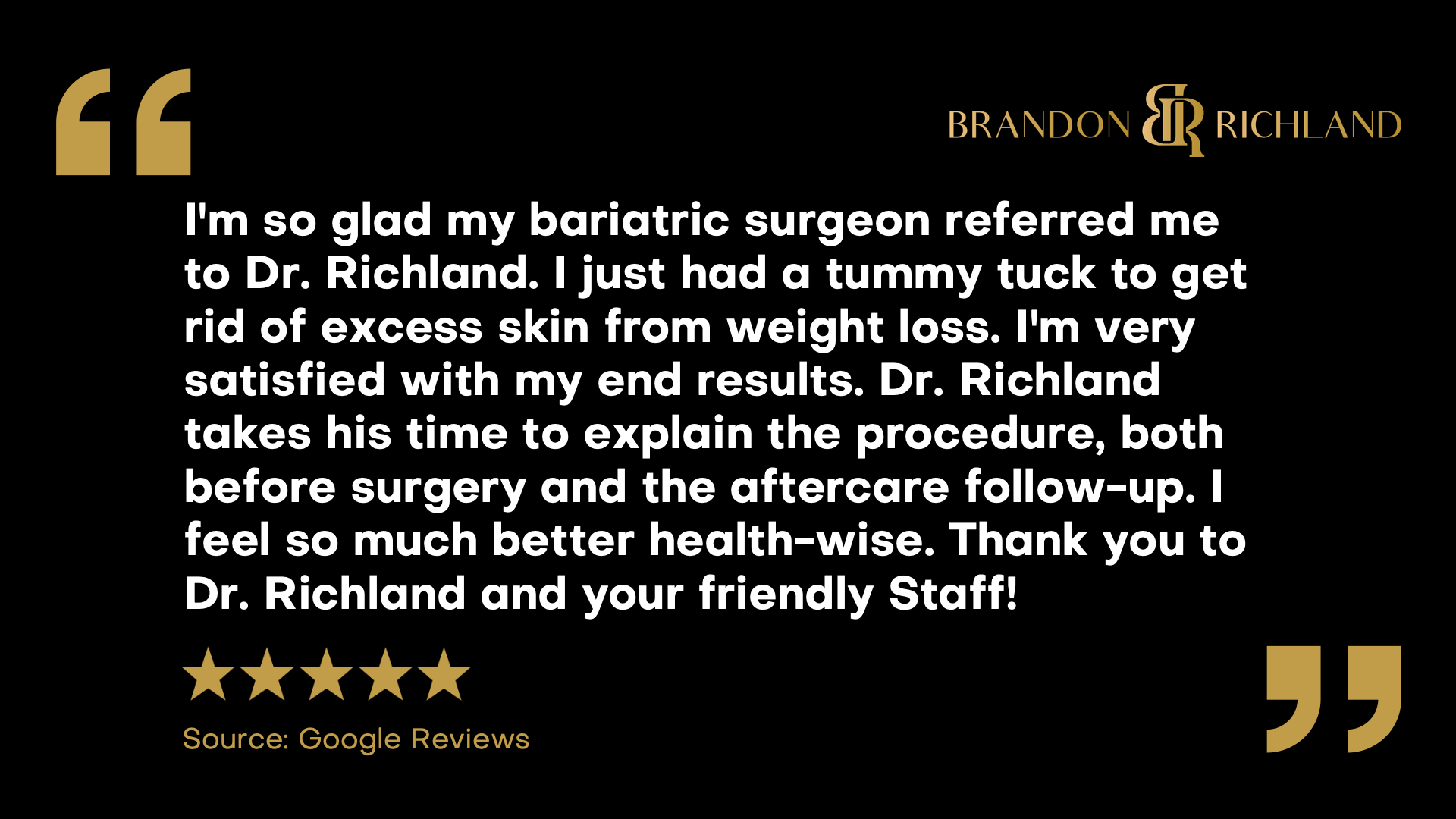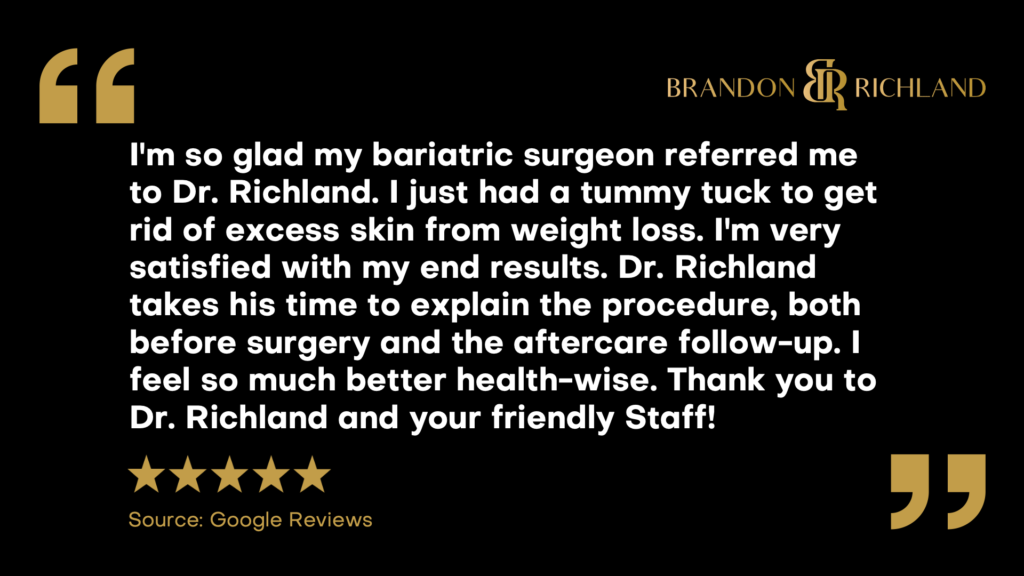Published by Dr. Brandon Richland, MD

“I’m so glad my bariatric surgeon referred me to Dr. Richland. I just had a tummy tuck to get rid of excess skin from weight loss. I’m very satisfied with my end results. Dr. Richland takes his time to explain the procedure, both before surgery and the aftercare follow-up. I feel so much better health-wise. Thank you to Dr. Richland and your friendly Staff!”
Read the full Google Review here.
Understanding Tummy Tuck Surgery
Tummy tuck surgery, medically known as abdominoplasty, is a cosmetic procedure designed to remove excess skin and fat from the abdomen and tighten abdominal muscles. This section provides an overview of what the surgery entails, who might be a good candidate, and what recovery involves.
The Tummy Tuck Procedure
The tummy tuck commences with an incision typically made along the lower abdomen from hip to hip, just above the pubic area. A second incision around the navel may be necessary to remove excess skin from the upper abdomen. The surgeon will then:
- Remove excess fat: May involve liposuction.
- Tighten abdominal muscles: With sutures for an improved abdominal profile.
- Reposition the belly button: To fit the new shape.
- Stretch and re-drape skin: Removing the excess before closing the incisions.
Final results are a flatter and firmer abdomen that aligns with the body’s contours.
Qualifications and Safety
A board-certified plastic surgeon should perform a tummy tuck. Candidates should be in good health, at a stable weight, and have realistic expectations. Before the surgery, a consultation will include:
- Discussing goals: Understanding what the patient hopes to achieve.
- Reviewing medical history: Including previous surgeries, current medications, and medical conditions.
Risks associated with tummy tuck surgery, such as scarring, bleeding, and infection, should be disclosed during the consultation.
Recovery and Aftercare
After a tummy tuck, patients can typically expect:
- Initial downtime: Most return to daily activities within 2 weeks.
- Full recovery period: Several weeks to months for full healing.
- Follow-up appointments: To monitor progress and the removal of drainage tubes or sutures.
- Instructions for self-care: Which may include guidelines on diet, exercise, and wound care.
Maintaining a healthy lifestyle is key to long-lasting results. It is crucial to follow the surgeon’s aftercare instructions closely for a smooth recovery and to reduce the risk of complications.
Factors Influencing Tummy Tuck Results
A tummy tuck can significantly improve the appearance of the abdomen after significant weight loss or pregnancy. However, several factors can influence the outcomes, ranging from weight fluctuations to lifestyle habits.
Impact of Weight Changes
Stable Weight: Maintaining a stable weight before and after a tummy tuck is critical for optimal results. Significant weight fluctuations can affect the longevity of the procedure’s outcome. Patients are generally advised to reach their target body weight before surgery and maintain it to ensure the removal of excess skin and fatty tissue aligns with their body’s final contour.
Weight Loss Surgery: Individuals who have undergone weight loss or bariatric surgery might see more substantial changes in their body mass index (BMI). After reaching a stable weight post-surgery, a tummy tuck can address the excess skin that often remains, which diet and exercise alone cannot.
Considerations for Skin Elasticity
Age and Elasticity: Age can affect skin elasticity, with younger skin typically having a better ability to snap back after being stretched. Consequently, younger patients might see more favorable results post-tummy tuck when it comes to the skin conforming to the body’s new shape.
Post-Pregnancy: Pregnancy often stretches the skin and abdominal muscles. A tummy tuck can tighten these muscles and remove loose skin. However, patients planning future pregnancies should consider postponing the procedure as subsequent pregnancies may reverse the effects.
Lifestyle and Maintenance
Healthy Lifestyle: Adopting a healthy lifestyle, which includes a balanced diet and regular exercise, is vital for maintaining tummy tuck results. A nutritious diet supports overall skin health, while physical activity helps in keeping excess fat at bay.
Smoking and Recovery: Avoiding tobacco products and alcohol is essential for proper healing. Smoking can impair blood flow and hinder the recovery process, potentially compromising the end result. It’s generally recommended that patients stop smoking well in advance of the surgery and during the recovery period.
By understanding these influencing factors, individuals can set realistic expectations and work towards the best possible results from their tummy tuck procedure.
Addressing Complications and Concerns
When considering a tummy tuck after significant weight loss, individuals should be aware of potential risks and the importance of post-surgical care.
Common Tummy Tuck Risks
A tummy tuck, or abdominoplasty, carries several risks common to surgical procedures. Individuals may experience pain and discomfort in the days following the surgery. Infection is a risk that can occur at the incision sites, which requires prompt medical attention. Bleeding and the formation of a seroma, a collection of fluid beneath the skin, are possible complications. Drainage tubes may be inserted to remove excess fluid and minimize the risk of seroma.
The development of blood clots can be a serious complication, particularly in the legs (deep vein thrombosis) or lungs (pulmonary embolism). Scarring is inevitable with any surgery, but the extent and visibility of scars can vary. Some individuals may also experience adverse reactions to anesthesia. It’s crucial for patients to discuss their complete medical history, including any history of gastric bypass or other surgeries, with their surgeon during the pre-operative consultation to manage these risks appropriately.
Post-Surgical Care and Monitoring
Adequate care after a tummy tuck is critical for wound healing. Surgeons typically provide specific guidelines on how to maintain hygiene at the incision sites and bandages may need regular changing. It’s essential to monitor for signs of infection such as increased redness, swelling, or unusual discharge. Patients should follow their prescribed pain medications and diet, and gradually reintroduce exercise as recommended by their healthcare provider.
Post-operative photographs may be taken during the follow-up visits to monitor the healing process. Engagement in behaviors that can impede recovery, such as smoking or taking NSAIDs, should be avoided. Patients who plan to get pregnant in the future may be advised to postpone the procedure, as pregnancy can alter the results of a tummy tuck. For those who have experienced massive weight loss and have excess skin in multiple areas such as the thighs, a full body lift may be considered in conjunction with or instead of a tummy tuck.
Tummy Tuck Variations and Related Procedures
A tummy tuck, or abdominoplasty, is not a one-size-fits-all procedure. It can be customized to fit the needs of individuals depending on the extent of excess skin and fat removal required, as well as the desire for additional body contouring procedures.
Mini vs. Full Abdominoplasty
Mini Abdominoplasty
- Involves a smaller incision when compared to a full abdominoplasty.
- Is suitable for patients who require less extensive correction, primarily below the belly button.
Full Abdominoplasty
- Requires a longer incision that runs from hip to hip.
- Ideal for patients with a significant amount of excess skin or fat, and those who need muscle tightening across the abdomen.
Both procedures may involve repositioning the belly button and can be combined with liposuction to remove excess fat. However, a full abdominoplasty addresses the entire abdominal area and usually leads to a more extensive recovery time.
Combining Procedures for Body Contouring
Combining abdominoplasty with other procedures often results in a more comprehensive improvement of the body’s contour.
Common Combinations Include:
- Liposuction: To remove stubborn fat deposits in the thighs, arms, or face.
- Breast Procedures: Such as a breast lift or augmentation for overall body proportion.
- Lower Body Lift: To address sagging skin around the waist, buttocks, and thighs.
- Arm Lift (Brachioplasty): To eliminate loose skin on the upper arms.
The choice to combine procedures depends on the patient’s goals, the surgeon’s evaluation, and the consideration of increased recovery time. Such combinations should be discussed extensively with a qualified surgeon to maintain safety and achieve the desired aesthetic outcomes.
Preparing for a Tummy Tuck
Before undergoing a tummy tuck, patients should carefully consider their goals for the procedure and adhere to specified preoperative guidelines. This preparation helps to ensure a smoother surgery and recovery experience.
Consultation and Goal Setting
A critical step in preparing for a tummy tuck, also known as abdominoplasty, is the initial consultation with the surgeon. Patients should be prepared to discuss their expectations and understand that while a tummy tuck can remove excess skin after significant weight loss, it is not a weight loss surgery.
- Key Aspects of the Consultation:
- Photographs may be taken for surgical planning.
- Discussion of the patient’s age, body type, and stable weight.
- Clarification of realistic goals and potential for scarring.
- Expectations regarding the procedure’s outcome will be set.
It’s crucial for patients to communicate their vision clearly and to understand the surgeon’s feedback about what is achievable.
Preoperative Guidelines and Considerations
Patients should commit to a healthy lifestyle, including proper nutrition and diet and exercise, months prior to the surgery to promote optimal results. A stable weight for some time is recommended to maintain results post-surgery.
Diet and Exercise:
- Consume a balanced diet for optimal healing.
- Maintain an exercise routine to achieve a stable weight.
Patients are advised to stop smoking and using tobacco products as they can impede healing. The avoidance of certain medications and supplements, such as aspirin and NSAIDs, that increase bleeding risk is imperative.
Preoperative Guidelines Checklist:
- Abstain from Smoking: At least 4-6 weeks pre- and post-surgery.
- Medications to Avoid: Aspirin, NSAIDs, and certain herbal supplements.
- Nutritional Advice: Follow dietary guidelines to support healing.
- Hygiene: Maintain good hygiene and follow any cleaning instructions provided.
Further, patients considering future pregnancy should discuss timing with their surgeon as it might affect the surgical outcomes. Preoperative preparations help in aligning the expectations with possible outcomes, leading to higher satisfaction with the final results.
Schedule Your First-Class Cosmetic Consultation with Dr. Brandon Richland, MD
Contact Dr. Richland today by visiting RichlandMD.com, scheduling a cosmetic consultation, or by calling 714-844-0398 or 949-997-2958 directly.











